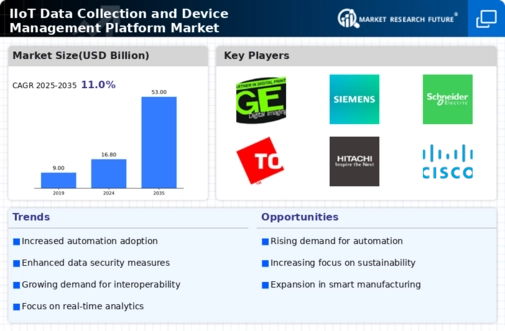Expansion of Industrial Automation
The expansion of industrial automation is a key driver for the IIoT Data Collection and Device Management Platform Market. As industries increasingly automate their processes, the need for effective data collection and device management becomes paramount. Automation technologies, such as robotics and advanced sensors, generate vast amounts of data that require sophisticated platforms for analysis and management. The market for industrial automation is projected to grow significantly, with estimates suggesting a CAGR of over 20% in the coming years. This growth is likely to fuel the demand for IIoT platforms that can seamlessly integrate with automated systems, enabling organizations to optimize their operations and enhance productivity. Consequently, the IIoT Data Collection and Device Management Platform Market stands to benefit from this trend as businesses seek to harness the power of automation.
Rising Demand for Real-Time Data Analytics
The IIoT Data Collection and Device Management Platform Market experiences a notable surge in demand for real-time data analytics. Industries are increasingly recognizing the value of immediate insights derived from data collected from various devices. This trend is driven by the need for enhanced operational efficiency and informed decision-making. According to recent estimates, the market for real-time analytics is projected to grow significantly, with a compound annual growth rate (CAGR) of over 25% in the coming years. Companies are leveraging IIoT platforms to harness data from sensors and devices, enabling them to monitor performance, predict maintenance needs, and optimize processes. This shift towards data-driven strategies is likely to propel the growth of the IIoT Data Collection and Device Management Platform Market, as organizations seek to remain competitive in an increasingly data-centric landscape.
Increased Regulatory Compliance Requirements
The IIoT Data Collection and Device Management Platform Market is influenced by increased regulatory compliance requirements across various sectors. Governments and regulatory bodies are implementing stringent guidelines to ensure data security, privacy, and operational safety. As organizations strive to comply with these regulations, the demand for IIoT platforms that offer robust data management and security features is likely to rise. Companies are investing in solutions that not only facilitate compliance but also enhance their overall operational capabilities. This trend indicates a potential growth opportunity for the IIoT Data Collection and Device Management Platform Market, as businesses seek to align their operations with regulatory standards while optimizing their data collection and management processes.
Growing Adoption of Smart Manufacturing Practices
The IIoT Data Collection and Device Management Platform Market is witnessing a growing adoption of smart manufacturing practices. As manufacturers strive to enhance productivity and reduce costs, the implementation of IIoT solutions becomes increasingly attractive. Smart factories leverage interconnected devices to collect and analyze data in real-time, facilitating improved production processes and resource management. Recent reports indicate that the smart manufacturing market is expected to reach a valuation of several billion dollars within the next few years, driven by the need for automation and efficiency. This trend underscores the importance of IIoT platforms in enabling manufacturers to achieve their operational goals, thereby propelling the growth of the IIoT Data Collection and Device Management Platform Market.
Integration of Artificial Intelligence and Machine Learning
The integration of artificial intelligence (AI) and machine learning (ML) technologies into the IIoT Data Collection and Device Management Platform Market is transforming how data is processed and utilized. AI and ML algorithms can analyze vast amounts of data collected from devices, identifying patterns and anomalies that may not be apparent through traditional methods. This capability enhances predictive maintenance, reduces downtime, and improves overall operational efficiency. As industries adopt these advanced technologies, the market for IIoT platforms is expected to expand, with AI-driven solutions becoming a key differentiator. The potential for AI and ML to revolutionize data management and analysis suggests a robust growth trajectory for the IIoT Data Collection and Device Management Platform Market, as organizations increasingly seek to leverage intelligent systems for better decision-making.


















Leave a Comment